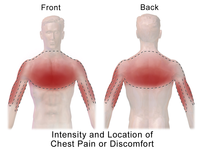
Photo from wikipedia
Background The relationship between shoulder pain and shoulder flexibility has not been clarified because of different views regarding differences in age or competition level among research-targeted swimmers. Studies to date… Click to show full abstract
Background The relationship between shoulder pain and shoulder flexibility has not been clarified because of different views regarding differences in age or competition level among research-targeted swimmers. Studies to date have hardly examined junior (aged 12 to 17) competitive swimmers. Objective To determine the risk factors related to shoulder pain and its prevention in junior competitive swimmers. Design A cross-sectional study. Setting Four swimming clubs belonging to the Hiroshima Prefecture Swimming Federation. Participants Eighty-one competitive swimmers (45 male and 36 female). Assessment of Risk Factors A self-administered questionnaire was used to investigate injury history with or without shoulder pain, years of swimming experience, and stroke specialty. To assess the effect of flexibility on shoulder pain, shoulder rotation width, latissimus dorsi flexibility, and internal rotation (IR) and external rotation (ER) angles in the second position were measured. Main Outcome Measurements Preliminary bivariate logistic regression analyses identified the aforementioned variables associated with shoulder pain, and variables with p values<0.15 were retained for the multivariate analyses. The independent predictors of shoulder pain as well as odds ratios and 95% confidence intervals were calculated from the final logistic regression model. Results Of the 81 participants, 57 (70.4%) had competitive swimming–related pain. Among them, 28 (49.1%) had shoulder pain, the most prevalent pain type. Male swimmers with low IR angles and fewer years of swimming experience were at 1.06 and 1.42 times greater risk of shoulder pain, while female swimmers with low IR and wider shoulder rotation widths were at 1.02 and 1.07 times greater risk of shoulder pain, respectively. Conclusions This study showed that low shoulder flexibility were significantly associated with shoulder pain. To apply these findings practically to identify swimmers who may be at increased risk of developing shoulder pain and the use of proper preventive programs may prevent shoulder pain.
Journal Title: British Journal of Sports Medicine
Year Published: 2017
Link to full text (if available)
Share on Social Media: Sign Up to like & get
recommendations!